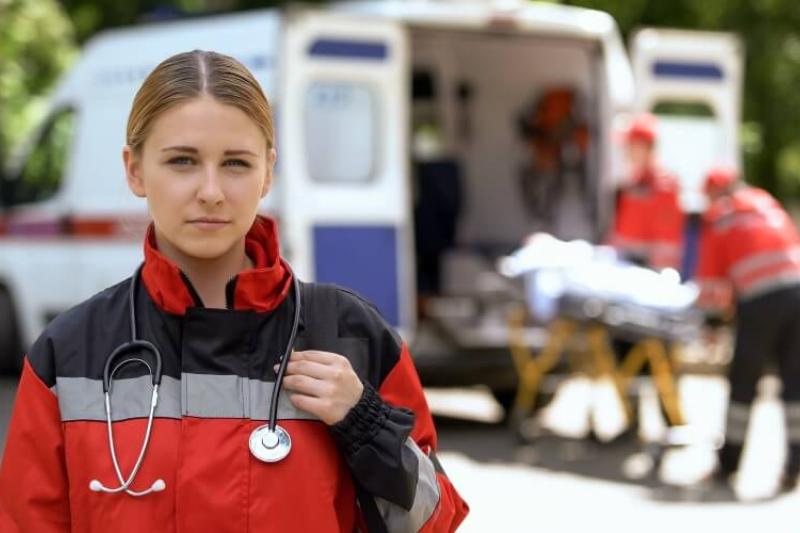- AdventHealth University

Humanitarian nurses provide critical healthcare to people who are in emergency situations. Responding to catastrophic events such as natural disasters and armed conflicts, these nurses apply their expertise in providing wholistic care under the most challenging conditions. Few if any medical professionals can match their impact. In fact, nurses in general deliver 80-90% of healthcare worldwide, according to Doctors Without Borders.
Providing Aid Around the World
Humanitarian nursing addresses an enormous need. Nearly 168 million individuals — roughly 1 in 45 people in the world — will need humanitarian assistance and protection in 2020, according to the United Nations. The U.N. projects that more than 200 million people could require assistance by 2022.
A closer look at the events that create health emergencies illustrates the critical need for humanitarian nurses, as well as the challenges they face.
Natural Disasters
Climate-related disasters threaten and disrupt millions of lives each year. In 2018 alone, more than 17 million people suffered displacements from storms, floods, earthquakes, droughts, wildfires and other natural disasters, according to the U.N.
Nurses were among the healthcare providers immediately called into action when cyclones hit Southern Africa in 2019. Tropical Cyclone Idai made landfall along the coast of central Mozambique in March, and six weeks later Cyclone Kenneth hit northern Mozambique. Affecting Malawi, Mozambique and Zimbabwe, high winds and massive flooding caused by the storms destroyed homes, power and sanitation systems, and crops. By August 2019, the death toll was over 600 and 2.5 million people were in need of humanitarian services, according to UNICEF. Humanitarian aid workers — including humanitarian nurses — responded by setting up mobile clinics, supplying clean water, distributing medical supplies, and fighting cholera and other waterborne diseases by providing mass vaccinations.
Fighting infectious diseases such as cholera, Ebola, influenza, COVID-19, and yellow fever is a major focus for humanitarian nursing, but caregivers also battle noncommunicable diseases such as cancers, cardiovascular diseases, diabetes, and respiratory diseases. Disproportionately affecting low- and middle-income countries, such diseases kill 41 million people annually, according to the World Health Organization (WHO).
Man-made Emergencies
Humanitarian nurses also respond to man-made emergencies such as transportation disasters and industrial accidents, as well as health crises caused by armed conflicts. As of the end of 2018, more than 70 million people were forcibly displaced worldwide, according to the U.N. Refugee Agency.
Healthcare emergencies resulting from armed conflict are not limited to battle injuries. Conflict is the main driver of hunger, according to the U.N., which estimates that more than 820 million people were undernourished at the beginning of 2019.
The complex costs of conflict have been painfully illustrated by the civil war that has ravaged Yemen since early 2015. As of late 2019, it is estimated that more than 100,000 Yemenis have died as a direct result of conflict, and more than 130,000 have died from indirect causes including starvation and disease. More than half of Yemen’s population lacks access to proper healthcare and clean water, according to the International Medical Corps.
Humanitarian nurses working to help refugees may operate in stationary or mobile health clinics, providing services ranging from primary care to disease prevention and reproductive health. Nurses operating in areas of armed conflict such as Yemen may have to triage and treat large numbers of patients with severe injuries. They are also more likely to see victims of sexual and gender-based violence. Additionally, one in five people living in conflict areas has a mental health condition, according to the U.N.
Many of the worst humanitarian emergencies result from a combination of natural and man-made disasters. Both climate change and conflict have contributed to eight of the world’s most severe food crises, according to the U.N.
Roles and Responsibilities
While many of the roles and responsibilities of humanitarian nurses are standard for their field, emergency conditions often require managing large numbers of patients with limited resources. Humanitarian nurses may be asked to act in more of an administrative role, managing medicines and medical supply inventories.
Humanitarian healthcare operations can also see heavy turnover, requiring nurses to perform more recruiting duties. This can include the training of local healthcare workers who bring varying skill levels. The role can also require more community outreach, working with local authorities and groups to organize food programs, hygiene protocols, and other critical solutions.
Nurses who excel at humanitarian aid tend to be sensitive to other cultures and customs. Flexibility and adaptability, particularly in dealing with limited resources, are also key traits. Skills of particularly high value in humanitarian nursing include the following.
- The ability to make decisions independently
- The ability to cope with stressful situations
- The ability to relate to and motivate staff
Nurses with varying levels of experience and specialization can perform humanitarian work, but those with backgrounds in emergency care, pediatrics, infectious diseases, and public health may be in particularly high demand. Knowledge of both English and a second language can be a valuable asset.
Challenges and Risks
Because the need for humanitarian nursing is linked to disasters, and because health crises can occur anywhere, humanitarian healthcare providers face unique and significant risks.
- Physical danger. The need for humanitarian nursing is often greatest in dangerous locations, including war zones, refugee camps, and remote locations with few resources.
- Cultural differences. Nurses who perform humanitarian work abroad may experience local customs and religious practices that challenge their own beliefs or principles.
- Psychological stress. The stress of emergency conditions can place humanitarian nurses at risk for burnout, and exposure to suffering can lead to depression.
Despite these challenges, for many nurses the opportunity to help the most vulnerable populations during times of great need is the most rewarding work of their careers.
How to Get Involved
Nurses who are interested in providing humanitarian aid can find opportunities in various types of organizations.
Ministries of Health
Every country has a government organization that provides health and medical services, including emergency care. In the U.S., the Department of Health and Human Services (HHS), including the U.S. Public Health Service, fills this role. The Centers for Disease Control and Prevention (CDC), a national organization that works internationally to fight disease, is part of the Public Health Service.
Intergovernmental Organizations (IGOs)
The United Nations (U.N.) oversees a vast network of intergovernmental groups with a mandate that includes humanitarian aid. Specialized agencies of the U.N. include the World Health Organization (WHO), which is responsible for international public health, and United Nations Children’s Fund (UNICEF), which provides humanitarian aid to children worldwide.
Non-governmental Organizations (NGOs)
A large number of organizations independent of government involvement provide humanitarian healthcare services, including nonprofit groups such as Médecins Sans Frontières (Doctors Without Borders), The International Medical Corps, and the Alliance for International Medical Action (ALIMA). Some operate worldwide, while others specialize in particular geographic regions. For example, ALIMA provides medical care and humanitarian assistance in Sub-Saharan Africa. Many NGOs are affiliated with religious organizations. Adventist Development and Relief Agency (ADRA), the humanitarian arm of the Seventh-day Adventist Church, provides disaster relief and community development assistance in 118 countries.
The Red Cross
Acting in an auxiliary role to public authorities, National Red Cross and Red Crescent Societies are neither government agencies nor wholly separate NGOs. Organizations within the International Red Cross and Red Crescent Movement make up a network of 80 million people who provide aid to those suffering from disasters, conflicts, and other health and social problems
Answering the Call
The need for humanitarian nurses and other healthcare providers has never been greater. The WHO estimates a projected shortfall of 18 million health workers by 2030, mostly in low- and lower-middle-income countries. The unique requirements of humanitarian aid — creative problem solving, adaptability, independent decision-making — calls for nurses with exceptional initiative and leadership skills.
The Bachelor of Science in Nursing (RN-BSN) degree program at AdventHealth Online helps develop nursing leaders and prepares RNs to advance their careers. Graduates serve in several professional capacities, including as registered nurses, registered nurse supervisors, and nurse managers.
One-third of nurses who graduated from the RN-BSN program moved into a management role, but the benefits of the program are not limited to professional development. The AdventHealth University Online RN-BSN program challenges students to re-imagine the role nurses can play in their communities. Learn more about the program today.
Recommended Reading
Career Spotlight: How to Become a Public Health Nurse Practitioner
RN vs BSN: Understanding the Difference
Sources:
Doctors Without Borders, Registered Nurses/Nurse Practitioners
Global Peace Careers, “5 Rewarding Humanitarian Jobs for Nurses”
International Committee of the Red Cross, Jobs in Health Care
International Federation of Red Cross and Red Crescent Societies, The Auxiliary Role
International Medical Corps, Conflict, Hunger, and Disease in Yemen
NGO Advisor, Top 20 NGOs World
One Nurse At A Time, “Humanitarian Nursing 101”
The American National Red Cross, Career Opportunities
United Nations Office for the Coordination of Humanitarian Affairs, Figures at a Glance


